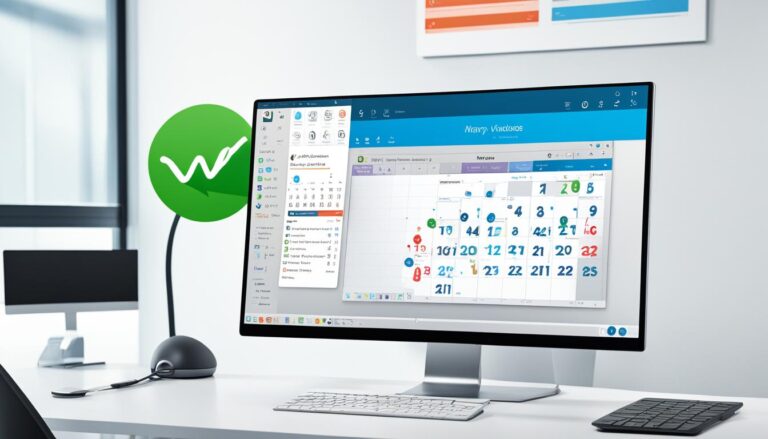Boost Your Business Productivity Today!

Are you struggling to keep up with the demands of your business? Are you looking for ways to increase productivity and efficiency? Look no further! In this article, we will explore effective strategies to boost your business productivity and take it to new heights. From automation and communication tools to fostering employee growth and optimizing the work environment, we have got you covered. Get ready to unlock the secrets to maximizing productivity and achieving success!
Key Takeaways:
- Maximizing automation and streamlining repetitive tasks can save time and improve productivity.
- Implementing effective communication tools can streamline collaboration and information sharing.
- Fostering employee growth and development can enhance skills and increase productivity.
- Creating a positive work environment with natural light, ergonomics, and reduced noise can boost productivity.
- Monitoring and measuring productivity is crucial for identifying areas of improvement.
Maximizing Automation and Streamlining Repetitive Tasks
One of the most effective strategies for increasing business productivity is by maximizing automation and streamlining repetitive tasks. Automation software and AI tools can save time and improve productivity by automating tasks that do not require critical thinking or creativity.
When selecting automation software, it is important to consider factors such as the size of the business, type of tasks to automate, and budget. Choose software that aligns with your specific needs and integrates seamlessly with your existing systems. This will ensure a smooth transition and maximize the efficiency of your automated processes.
Automation software can streamline various tasks such as data entry, report generation, and customer service inquiries. By automating these repetitive tasks, your employees can focus on more important responsibilities that require critical thinking and creativity. This not only increases individual productivity but also contributes to the overall productivity of your business.
Measuring productivity is crucial to track progress and optimize productivity in the long run. By implementing key performance indicators (KPIs) and tracking relevant metrics, you can assess the effectiveness of your automated processes. This data-driven approach allows you to identify areas for improvement and make informed decisions to further enhance productivity.
| Benefits of Maximizing Automation and Streamlining Tasks |
|---|
| Time savings |
| Reduced errors |
| Increased efficiency |
| Improved scalability |
| Enhanced employee satisfaction |
By maximizing automation and streamlining repetitive tasks, you can unlock the full potential of your business and achieve higher levels of productivity. Adopt automation software that fits your business needs, track and measure productivity, and continuously optimize your processes to stay ahead in today’s competitive landscape.

Testimonials – How Automation Software Transformed Businesses
- “Implementing automation software was a game-changer for our business. It allowed us to automate mundane tasks, freeing up valuable time for our team to focus on strategic initiatives. As a result, our productivity skyrocketed, leading to significant growth and success.” – Jane Simmons, CEO of XYZ Company.
- “Automation software has revolutionized how we operate our business. It has eliminated manual errors, streamlined our workflows, and improved overall efficiency. We now have more time to dedicate to innovation and delivering exceptional customer experiences.” – Mark Thompson, COO of ABC Corporation.
Enhancing Communication and Collaboration
Effective communication and collaboration are essential for the success of any business. By implementing the right tools and strategies, you can streamline communication, foster collaboration, and boost productivity. In this section, we will explore some of the most effective communication tools that can enhance collaboration and information sharing within your teams.
Instant Messaging
Instant messaging platforms offer real-time communication, allowing team members to connect and exchange messages instantly. These tools provide a convenient way to ask quick questions, share updates, and collaborate on projects without the need for lengthy email chains or in-person meetings.
With instant messaging, you can create separate chat groups for different teams or projects, ensuring efficient communication and easy access to relevant conversations. Tools like Slack, Microsoft Teams, and Google Chat are popular options that offer various features such as file sharing, video calls, and integration with other productivity tools.
Project Management Software
Collaboration becomes more effective when using project management software. These tools provide a centralized platform where teams can organize tasks, set deadlines, and track progress. Project management software like Asana, Trello, and Jira enable teams to assign tasks, share files, and communicate within the context of specific projects.
By using project management software, you can ensure that everyone has clear visibility into project timelines, responsibilities, and updates, promoting transparency and collaboration. These tools also enhance productivity by reducing the time spent on searching for project-related information and keeping all relevant documentation in one place.
In addition to instant messaging and project management software, collaboration tools like Google Docs and Dropbox simplify file sharing and enable real-time editing, ensuring seamless collaboration on documents, presentations, and spreadsheets.

Implementing the right communication tools is just the first step. It is equally important to ensure that your team members are equipped with the necessary knowledge to use these tools effectively. Provide training and resources to enhance their understanding and proficiency, emphasizing the importance of clear and concise communication, active listening, and timely response.
By enhancing communication and collaboration within your teams, you can foster a work environment that encourages effective information sharing, teamwork, and innovation. The result is improved productivity, increased efficiency, and ultimately, a stronger and more successful business.
Fostering Employee Growth and Development
Fostering continuous learning opportunities, mentoring, and coaching is essential for nurturing employee growth and development. By investing in their personal and professional advancement, you empower your team members to improve their skills and contribute more effectively to your business. Providing access to continuous learning opportunities allows employees to stay ahead of industry trends, acquire new knowledge, and develop innovative approaches to their work.
Mentoring and coaching programs can provide invaluable guidance and support to employees as they navigate their career paths. Pairing experienced leaders with individuals seeking growth and development creates a nurturing environment where knowledge, skills, and experiences are shared. Through mentorship and coaching, employees gain valuable insights, receive personalized feedback, and build confidence in their abilities. This collaborative relationship fosters employee growth and builds a strong foundation for success.
Investing in employee growth and development not only benefits individuals but also has a positive impact on your business. By offering opportunities for personal and professional growth, you can increase employee satisfaction, motivation, and loyalty. When employees feel supported and valued, they are more engaged and committed to achieving the organization’s goals. This translates into enhanced productivity and innovation within your team.
The Benefits of Employee Growth and Development
Investing in the growth and development of your employees can yield a range of benefits for your business. Here are some key advantages:
- Increased employee productivity: Continuous learning enables employees to enhance their skills and knowledge, leading to improved performance and productivity.
- Enhanced employee satisfaction and retention: Offering growth opportunities demonstrates your commitment to your employees’ long-term success, fostering loyalty and reducing turnover.
- Development of future leaders: By nurturing employees’ potential, you can build a pipeline of talented individuals who can step into leadership roles within your organization.
- Improved adaptability and innovation: Continuous learning encourages employees to stay updated on emerging trends and technologies, fostering adaptability and driving innovation in your business.
Investing in employee growth and development is an investment in the future success of your business. By providing continuous learning opportunities, mentoring, and coaching, you create an environment that supports employee growth and fosters a culture of learning and improvement.

Case Study: Company XYZ’s Employee Development Program
| Program Components | Outcomes |
|---|---|
| Continuous learning opportunities through online courses, workshops, and conferences | Employees gained new skills and knowledge, leading to increased productivity and innovation. |
| Mentoring program pairing senior leaders with junior employees | Employees received guidance, feedback, and advice, fostering their professional growth and development. |
| Coaching sessions focusing on individual goals and areas of improvement | Employees developed strategies to overcome challenges, leading to improved performance and job satisfaction. |
| Leadership development programs for high-potential employees | Employees identified as future leaders underwent specialized training, preparing them for leadership positions within the company. |
Enhancing the Work Environment
In order to boost productivity in your business, it is crucial to create an optimal work environment. Several factors contribute to a positive and conducive workspace, including natural light, ergonomics, and noise reduction strategies. By prioritizing these elements, you can significantly improve employee well-being and overall productivity.
The Power of Natural Light
Natural light has proven benefits for both mental and physical well-being. Exposure to natural light can boost mood, improve focus, and regulate sleep patterns. It also reduces eye strain and enhances visual clarity, which promotes better concentration and overall productivity. When designing your workspace, consider maximizing access to natural light by positioning workstations near windows or utilizing skylights.
Ergonomics for Comfort and Efficiency
Poor ergonomics can have a detrimental impact on employee health and productivity. When workstations are not properly set up, it can lead to discomfort, muscle strain, and fatigue. Investing in ergonomic furniture and equipment, such as adjustable chairs, standing desks, and ergonomic keyboards, can significantly improve employee comfort and reduce the risk of injuries and musculoskeletal disorders. By creating a comfortable and ergonomic workspace, employees can work more efficiently and perform at their best.
Noise Reduction for Focus
Noise distractions in the workplace can hinder concentration and productivity. Implementing noise reduction strategies, such as sound-absorbing materials, white noise machines, or designated quiet areas, can help create a calm and focused work environment. By minimizing distractions, employees can concentrate better on their tasks, resulting in improved productivity and performance.
To summarize, optimizing your work environment with natural light, ergonomic furniture, and noise reduction strategies can have a significant impact on employee well-being and productivity. By providing a supportive and conducive workspace, you can create an environment that promotes focus, comfort, and efficiency.
Monitoring and Measuring Productivity
Monitoring and measuring productivity are crucial components of optimizing business efficiency and effectiveness. By tracking progress and performance through various metrics and tools, you can gain valuable insights and identify areas for improvement. With this data-driven approach, you can make informed decisions to enhance productivity and drive success.
When monitoring productivity, consider utilizing key performance indicators (KPIs) that align with your business goals. These KPIs can vary depending on the nature of your organization, but common metrics to measure productivity include:
- The number of completed tasks or projects within a specific time frame
- The average time taken to complete a task or project
- The level of resource utilization and efficiency
- The rate of customer satisfaction or feedback
By regularly tracking these metrics, you can identify trends and patterns that reveal insights into your team’s productivity levels. This information can help you pinpoint potential bottlenecks or areas that require additional support or improvement.
Implementing Productivity Measurement Tools
To streamline the process of monitoring productivity, consider leveraging productivity measurement tools. These tools can automate data collection, provide real-time analytics, and generate comprehensive reports. Here are some popular productivity measurement tools:
| Productivity Measurement Tools | Description |
|---|---|
| Time tracking software | Tracks the time spent on different tasks or projects, helping you identify time-wasting activities and inefficiencies. |
| Project management software | Allows you to monitor project progress, allocate resources, and track milestones, enabling better productivity oversight. |
| Data analytics platforms | Provide comprehensive data analysis and visualization tools that offer valuable insights into your team’s performance and productivity. |
| Customer feedback software | Enables you to collect feedback from customers, helping you gauge customer satisfaction levels and make improvements accordingly. |
By leveraging these tools, you can streamline the monitoring and measurement process, allowing you to focus on analyzing the data and implementing strategies to improve productivity.

By consistently monitoring and measuring productivity, you can optimize your business’s performance, identify areas for improvement, and drive growth. Remember that productivity is not a one-time achievement but an ongoing process that requires continuous evaluation and adaptation.
Conclusion
Boosting business productivity is crucial for increasing efficiency and achieving success in today’s competitive landscape. By implementing a multi-faceted approach that maximizes automation, enhances communication, fosters employee growth, optimizes the work environment, and monitors productivity, businesses can create a high-performance culture that drives results.
Maximizing automation through the use of automation software and AI tools allows employees to focus on critical thinking and creative tasks, resulting in increased productivity. Effective communication tools and collaboration platforms streamline information sharing and foster teamwork, further contributing to overall productivity improvement.
Fostering employee growth and development through continuous learning opportunities, mentoring, and coaching enhances skills and creates a motivated workforce. Investing in a positive work environment with features like natural light, ergonomic workstations, and noise reduction strategies enhances employee well-being and productivity.
Finally, monitoring and measuring productivity is essential for identifying areas of improvement and making data-driven decisions. By implementing these strategies and continuously adapting to change, businesses can boost performance, increase productivity, and create a culture of success.






